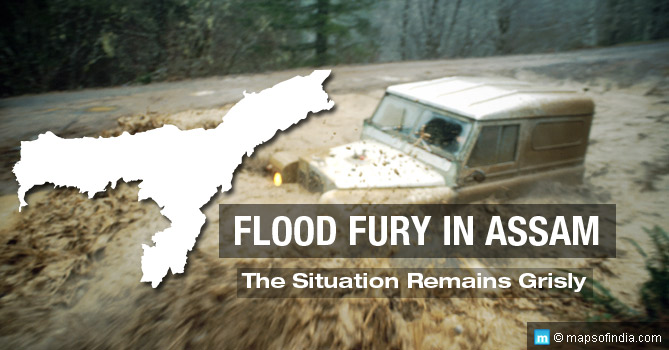Assam is once again submerged in floods, an annual feature that people of the state have been living with ever since time immemorial. Year after year, it’s a repeat of loss of life, damage to crop and property, and loss of cattle and wildlife, but does it have to be this way?
We take great pride in claiming how far India has come since independence and yet, when it comes to Assam, the nation simply seems to take the damages as a fact of life and everything carries on as usual, once the flood recedes.
Despite investments by successive central or state governments, it is time to review the long term cost-benefit analysis of measures undertaken and see whether the solutions attempted so far have addressed the problem at its root.
The damage this year
The ‘Flood Report’ released by Assam State Disaster Management Authority as on 28 July 2016 states:
- Districts affected: 22
- People affected: 17.94 lakh
- Total Crop area affected: 2,13,251.52 hectares
- Most affected districts: Morigaon, Jorhat, Dhubri, Barpeta, Lakhimpur, Golaghat, Sonitpur, Goalpara, Bongaigaon, Dhemaji and Darrang
- No. of Relief Camps opened: 517
- Relief Distribution Centres: 186 – sheltering 2,29,544 inmates
The situation began to turn critical ever since the state experienced pre-monsoon showers in April and May this year. The breach in embankments along the Brahmaputra river and its various tributaries has caused flooding in 23 out of 35 districts in the state and has submerged crops in over 2 lakh hectares.
Consequently, 1.1 million people have been affected, with 28 persons losing their lives and over 1.5 lakh persons seeking shelter in over 460 relief camps.
In many parts, people have remained marooned with little food or drinking water and await relief and rescue. NDRF teams have been deployed and are trying their best to reach out to maximum people.
With 80% of the famous Kaziranga National Park submerged, Assam’s pride – the one-horned Rhinos and other wildlife across the state, have had to face the brunt of swelling waters. The Wildlife Trust of India, along with various Forest department officials, have been under pressure rescuing animals but many have drowned while others continue to remain marooned.
Morigaon in lower Assam has been most affected, where over 3.6 lakh people have had to face flood waters. The entire Majuli riverine island, that forms a large part of Jorhat district, lies submerged, affecting over 1.71 million people.
Every year, over 31.6 lakh hectares of land in Assam is flood prone. Of this, around 9.5 lakh hectares gets directly affected by floods each year. The total damage caused exceeds Rs 160 crore annually.
The state has paid a heavy price through land erosion caused by floods. Since 1954, over 4.2 lakh hectares of land has been lost to erosion, that’s over 7.1% of the state.
Over the years, maximum erosion has taken place in South Assam region, with Makalmua in Nalbari (80,000 hectares), Majuli island (42,000 hectares), Goalpara area (40,000 hectares) and Morigaon (15,000 hectares) being most affected.
The Mighty Brahmaputra
This is the world’s 6th largest river in terms of water resources carrying 629.05 km3/ year. The total length of the river is 2,906 km, with 918 km flowing through India, which includes 640 km flowing through Assam.
Brahmaputra has 41 tributaries, with 26 flowing in the North bank and 15 in the South bank.
Immediate cause of floods
Heavy rains this year in Arunachal Pradesh, Bhutan and Upper Assam have resulted in the Brahmaputra and its tributaries to flow above the danger mark. The excess water has broken embankments in many places causing severe floods along the route, especially in regions of Lower Assam.
Major causes of flood and soil erosion
Natural causes:
- Geology and Geomorphology of the region
- Physiographic condition in the valley
- Seismic activity
- Excessive rainfall
Man-made causes:
- Drainage congestion due to man-made embankments
- Human encroachment of riverine areas
The narrow and elongated U-shaped valley opens itself wider towards the Bay of Bengal for monsoon flow. The average width of the valley is 80-90 km while the average width of the river is 6-10 km. The natural course of the river flows from high elevation to a steep falling elevation once the river enters India.
Between Brahmaputra valley and the North East Hills, the average rainfall during monsoons varies between 2,480 mm to 6,350 mm, respectively. Due to excess rainfall, water gushes towards lower parts of Assam, eating away the relatively soft edges of land.
The physiology of the region is still young and the lesser Himalaya regions are still in the process of forming. The soft rocks, in the absence of green top cover, easily gives way to gushing waters.
The problem is further compounded by human settlements along the river and its various tributaries, thereby restricting the flow to follow its natural spread in times of flood.
The building of embankments along the Brahmaputra and its tributaries has only added to flooding waters breaking embankments.
Drainage congestion due to building of railway bridges, roads and culverts have restricted the natural flow of waters, forcing it to back flow and break embankments in vulnerable areas.
Lack of countryside drainage through construction of sluices at critical points have also added to drainage congestion.
Lack of Commitment and Vision
There has been very low investment made to address the problem of perennial flooding in Assam. During the 10th Five year plan, only Rs 22 crore had been allocated for 10 flood management programs. This is an average of just Rs 2.2 crore for each program. This is for a state that has lost 4.2 lakh hectares of land to erosion and continues to suffer damages of over Rs 160 crore each year on account of floods.
Although international funding and increased financial investment from centre has improved, long term solutions still need to be addressed.
The Solution
There has been excess emphasis for investing in structural solutions like building of embankments and little focus on natural flood control mechanisms based on local topography.
Till date, close to 5,000 km of embankments have been built at various points along the Brahmaputra and its tributaries. This has resulted in restricting the flow of river during peak monsoons and caused increased pressure on embankments in vulnerable areas leading to embankments being breached at several places.
While people living along the rivers have traditionally developed their own means of surviving the raging waters, those living around the safer areas next to embankments have often been caught by surprise.
It is time for the government and related agencies to review the existing policy of building embankments without considering natural outlets for excess water to flow. This will work best when local people are made stakeholders in finding localized solutions based on local topography.
During floods, lack of clean drinking water is the biggest problem. Today, thanks to innovative science, there are several low-cost water filtration and purification technologies available, which people can deploy in times of floods. The government must spend more in creating awareness and making the same available at subsidized cost to people.
Let’s hope the government gives the problem the requisite attention and investment to ensure that from 2017 onwards Assam will be better prepared to meet the monsoons.
Read More:
Top Ten Flood Prone Areas in India
Tips on How to Protect Yourself from Floods
Guidelines for Flood Control





